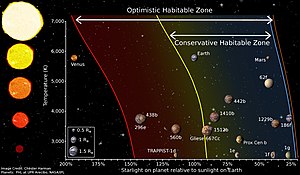Circumstellar habitable zone

In astronomy and astrobiology, the circumstellar habitable zone (CHZ), or simply the habitable zone, is the range of orbits around a star within which a planetary surface can support liquid water given sufficient atmospheric pressure. The bounds of the CHZ are based on Earth's position in the Solar System and the amount of radiant energy it receives from the Sun. Due to the importance of liquid water to Earth's biosphere, the nature of the CHZ and the objects within it may be instrumental in determining the scope and distribution of planets capable of supporting Earth-like extraterrestrial life and intelligence.
The habitable zone is also called the Goldilocks zone, a metaphor, allusion and antonomasia of the children's fairy tale of "Goldilocks and the Three Bears", in which a little girl chooses from sets of three items, ignoring the ones that are too extreme (large or small, hot or cold, etc.), and settling on the one in the middle, which is "just right".
Since the concept was first presented in 1953, many stars have been confirmed to possess a CHZ planet, including some systems that consist of multiple CHZ planets. Most such planets, being either super-Earths or gas giants, are more massive than Earth, because such planets are easier to detect.citation needed On November 4, 2013, astronomers reported, based on Kepler data, that there could be as many as 40 billion Earth-sized planets orbiting in the habitable zones of Sun-like stars and red dwarfs in the Milky Way. 11 billion of these may be orbiting Sun-like stars. Proxima Centauri b, located about 4.2 light-years (1.3 parsecs) from Earth in the constellation of Centaurus, is the nearest known exoplanet, and is orbiting in the habitable zone of its star. The CHZ is also of particular interest to the emerging field of habitability of natural satellites, because planetary-mass moons in the CHZ might outnumber planets.
In subsequent decades, the CHZ concept began to be challenged as a primary criterion for life, so the concept is still evolving. Since the discovery of evidence for extraterrestrial liquid water, substantial quantities of it are now thought to occur outside the circumstellar habitable zone. The concept of deep biospheres, like Earth's, that exist independently of stellar energy, are now generally accepted in astrobiology given the large amount of liquid water known to exist within in lithospheres and asthenospheres of the Solar System. Sustained by other energy sources, such as tidal heating or radioactive decay or pressurized by non-atmospheric means, liquid water may be found even on rogue planets, or their moons. Liquid water can also exist at a wider range of temperatures and pressures as a solution, for example with sodium chlorides in seawater on Earth, chlorides and sulphates on equatorial Mars, or ammoniates, due to its different colligative properties. In addition, other circumstellar zones, where non-water solvents favorable to hypothetical life based on alternative biochemistries could exist in liquid form at the surface, have been proposed.
Comments
Post a Comment